The Delosperma Guide
Delosperma, commonly known as ice plant, is a low-growing, mat-forming succulent known for its dazzling flowers and remarkable drought tolerance. With vibrant daisy-like blooms in a range of electric colors and fleshy evergreen foliage, Delosperma brings texture and year-round interest to dry, sunny spots. These hardy perennials thrive in rock gardens, slopes, borders, and containers, offering extended color through spring, summer, and sometimes even fall.
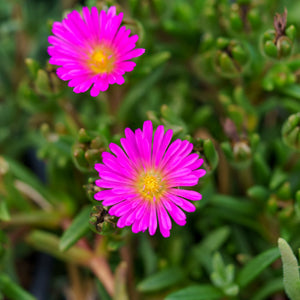
About
Native to South Africa, Delosperma is part of the Aizoaceae family and includes numerous species and hybrids bred for cold hardiness and flower power. What sets Delosperma apart is its brilliant display of iridescent, nearly fluorescent blooms that open in sunlight and close in shade or darkness. The succulent foliage provides a lush, water-wise groundcover that survives heat, poor soils, and neglect.
Cultivars like Delosperma 'Fire Spinner'—with tri-colored blooms of orange, pink, and white—have gained popularity for their eye-catching appeal. The 'Jewel of the Desert' series includes bold varieties such as 'Garnet', 'Peridot', 'Ruby', 'Grenade', and 'Topaz', each offering long bloom times and compact habits. The 'Wheels of Wonder' series features larger flowers, including 'Golden Wonder', 'Hot Pink Wonder', 'Violet Wonder', and 'Fire Wonder'. Newer introductions like 'Ocean Sunset Orange Glow' and 'Pumpkin Perfection' expand the palette with rich, sunset tones.
Delosperma is not only a visual standout—it’s a problem-solver for tough, dry locations and a magnet for pollinators like bees and butterflies.
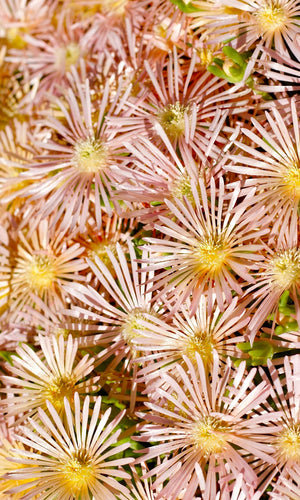
PLANTING
Delosperma thrives in hot, dry environments and should be planted with good drainage in mind. Proper placement and soil prep are essential for its success:
- USDA Hardiness Zones: Most varieties are hardy in Zones 5–9, depending on the cultivar.
- Soil: Requires well-drained, sandy, or gravelly soil. Avoid clay or compacted soils.
- Sunlight: Full sun is critical for flowering and overall vigor.
- Watering: Water to establish, then reduce. Overwatering can lead to rot.
- Spacing: Plant 12–18 inches apart to allow spreading.
- Planting Time: Best planted in spring or early summer when the risk of frost has passed.
For planting, dig a hole just slightly larger than the root ball. Mix in grit or sand if soil is heavy. Set the plant at soil level, fill in, and water lightly. A layer of gravel mulch can enhance drainage and visual appeal.
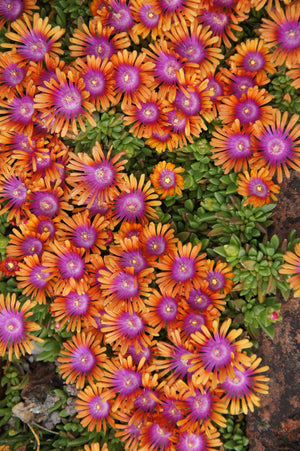
CARE
Delosperma is one of the lowest-maintenance perennials you can grow, provided it’s not overwatered. Here’s how to keep it looking its best:
- Watering: Once established, water only during extended drought. It prefers dry conditions and can rot in wet soils.
- Fertilizing: Apply a light dose of balanced fertilizer in spring. Too much fertilizer can reduce blooming.
- Pruning: Trim lightly to shape or remove any winter damage in spring.
- Pests & Diseases: Generally pest-free. Root rot can occur in poorly drained soil.
- Winter Care: In colder climates, provide gravel mulch for extra drainage and avoid winter wetness.
- Propagation: Easy to propagate from stem cuttings or division. Allow cut ends to callous before planting.
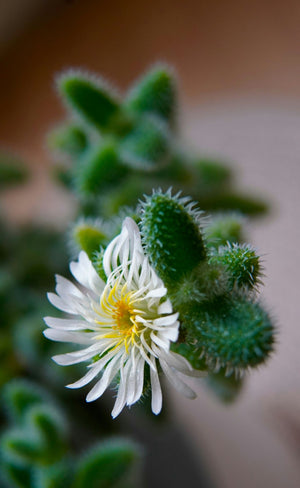
HOW TO USE
Delosperma adds a burst of color and texture to a wide range of dry garden settings. Its ability to hug the ground and spread makes it ideal for solving design and erosion challenges:
- Rock Gardens & Slopes: Perfect for hot, sunny, sloped areas with well-drained soil.
- Borders & Edging: Use along pathways, retaining walls, or the front of sunny borders.
- Containers & Troughs: Excellent for shallow pots and rock garden containers.
- Groundcover: Fills gaps between stones or in dry open spaces where grass struggles.
- Pollinator Gardens: Attracts bees and butterflies with long-lasting blooms.
Pair Delosperma with other drought-tolerant plants like sedum, sempervivum, lavender, penstemon, or ornamental grasses for a vibrant and resilient planting scheme.
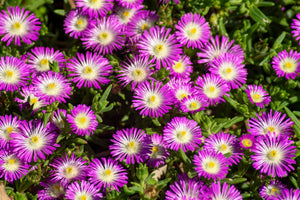
COMMON QUESTIONS
- Is Delosperma a perennial? Yes, most Delosperma varieties are cold-hardy perennials in Zones 5–9.
- Is Delosperma deer resistant? Yes, Delosperma is typically deer-resistant due to its succulent leaves.
- How to care for Delosperma? Plant in full sun with well-drained soil, water sparingly, and prune in spring as needed.
- How to grow Delosperma? Provide sandy soil, good drainage, and lots of sun. Avoid overwatering.
- How to plant Delosperma? Space plants 12–18 inches apart in full sun, in gravelly or sandy soil. Mulch with stone for best effect.
- How to propagate Delosperma? Take stem cuttings in summer or divide clumps in spring. Let cuttings callous before planting.
- Is Delosperma toxic to dogs? Delosperma is considered non-toxic to dogs.
- Is Delosperma toxic to cats? Delosperma is considered non-toxic to cats.
Conclusion
Delosperma is a brilliant, water-wise groundcover that brings months of vivid color to hot, dry gardens. Whether you love the shimmering tri-color of 'Fire Spinner', the jewel tones of the 'Jewel of the Desert' series, or the big blooms of 'Wheels of Wonder Golden Wonder', Delosperma delivers beauty with little effort. Ideal for rock gardens, borders, or containers, this succulent perennial provides reliable performance and visual impact from spring to frost.
The Delosperma Collection
Sold Out
Sold Out
Sold Out
Sold Out
Sold Out






